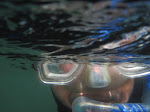
Consider these words from Ishmael, the narrator of Herman Melville's classic Moby-Dick:
"The skeleton dimension I shall now proceed to set down are copied verbatim from my right arm, where I had been tattooed; as in my wild wanderings at that period, there was no other secure way of preserving such valuable statistics. But as I was crowded for space, and wished the other parts of my body to remain a blank page for a poem I was then composing--at least, what untattooed parts might remain--I did not trouble myself with the odd inches; nor, indeed, should inches at all enter into a congenial admeasurement of the whale."
This passage may be found at the end of Chapter CII: A Bower in the Arsacides, just before Chapter CIII: Measurement of the Whale's Skeleton.
Ishmael's practical tattooing--using his skin as a notebook--is a remarkably broad-minded advance on Typee's trepidation at being marked as a cannibal, savagely disfigured and so unfit to return to civilization, in Melville's first novel. Typee's obvious discomfort prevented the Marquesan islanders from honoring him, as they saw it, with the tribal adornments to Melville's alter ego's immense relief.
Not so many years later--according to conventional chronology, anyway--Melville in Moby-Dick changes the tune; Ismael regards tattooing as means to either a practical or poetic end. In fact, due to the white whale's sinking of the Pequod, Ishmael loses all possessions save Queequeg's life-saving coffin and his own skin, fortuitously marked. (Queequeg's hieroglyphic and profound markings deserve a separate entry.)
I must quote Thomas Farber's wonderful line, his counter to Melville's famous opening: "Call me Queequeg."
Ishmael's poem must be that novel I'm rereading.



















